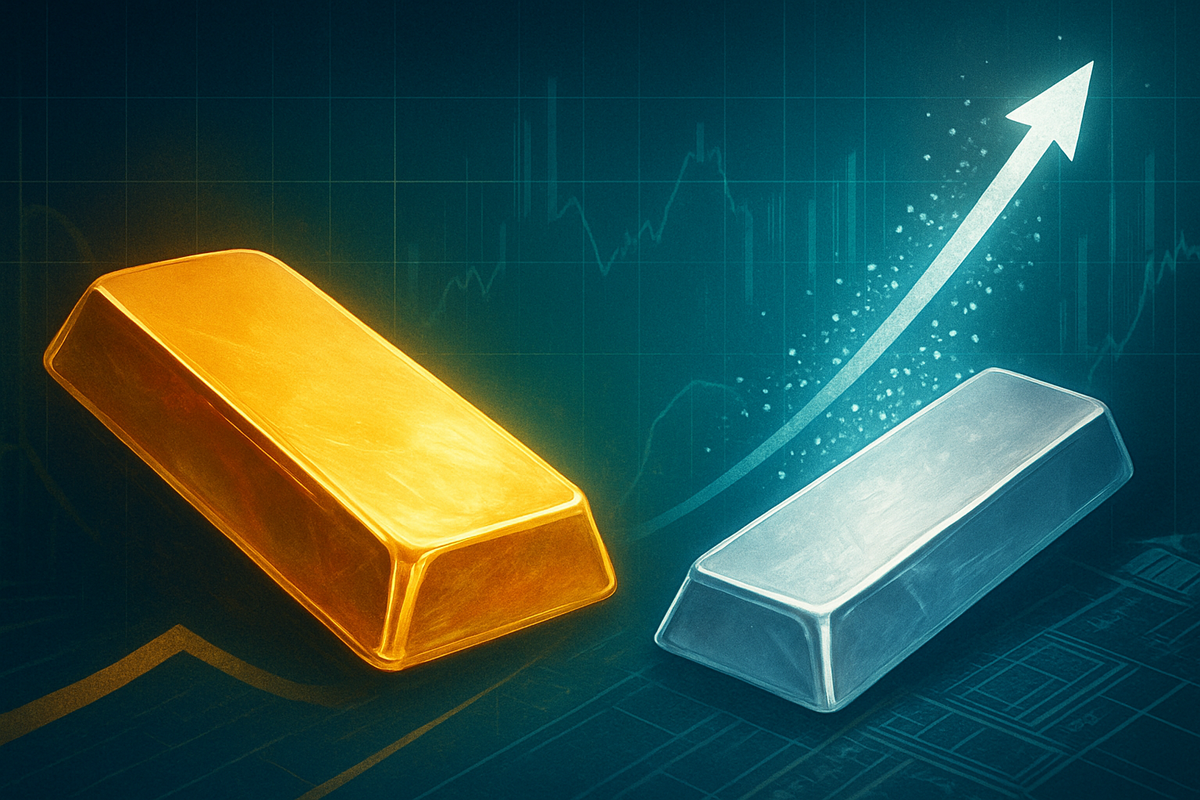
The precious metals market is currently a tale of two metals: gold is experiencing a significant price correction after a historic rally, while silver is in the midst of an unprecedented short squeeze, propelled by its recent designation as a critical mineral in the United States. As of October 27, 2025, gold prices have pulled back from record highs, prompting widespread profit-taking and a recalibration of market expectations. Simultaneously, silver's new strategic importance is amplifying an already acute supply deficit, driving its price to levels not seen in decades and creating substantial volatility across global financial markets.
This divergence highlights a complex interplay of macroeconomic factors, industrial demand shifts, and evolving government policies. The gold correction, while sharp, is largely viewed as a healthy consolidation within a long-term bullish trend, whereas the silver squeeze underscores critical vulnerabilities in global supply chains for essential industrial materials. Investors and industry stakeholders are closely monitoring these dynamics, as they portend significant implications for mining companies, industrial consumers, and the broader economic landscape.
Gold's Retreat and Silver's Ascent: A Detailed Market Snapshot
Gold's recent performance has been marked by a sharp technical correction, following an extraordinary year-to-date rally that saw its price surge over 50% and peak at approximately $4,382 per ounce earlier in October 2025. On October 27, 2025, gold traded around $3,985.34 USD/t.oz, representing a 3.08% decline from the previous day. This correction was primarily triggered by widespread profit-taking by institutional investors, a temporary reduction in aggressive central bank purchasing, and a reported boost in risk appetite stemming from progress in US-China trade negotiations, dampening safe-haven demand. The market witnessed its steepest two-day decline since 2013, including a notable 6.3% plunge on October 21, 2025.
In stark contrast, silver is experiencing an unprecedented "short squeeze," pushing its spot price past $50 per ounce and even touching $53.62 in October 2025, marking a staggering year-to-date gain of approximately 70%. This dramatic surge is fueled by a confluence of factors, critically amplified by the U.S. government's recent designation of silver as a critical mineral. The U.S. Geological Survey (USGS) and the U.S. Department of the Interior officially added silver to the 2025 Critical Minerals list as of August 25, 2025, recognizing its strategic importance for economic and national security. This classification allows for potential government intervention, including strategic stockpiling, tax incentives for domestic production, and prioritization of supplies for critical sectors. The squeeze is further exacerbated by acute physical shortages, persistent supply deficits since 2021, soaring industrial demand from green energy sectors (solar panels, electric vehicles), surging retail and institutional investment demand, and significant inventory depletion from COMEX warehouses.
Key players involved in these market movements include major central banks, institutional investors like BlackRock (NYSE: BLK) and Vanguard (NYSE: VOO), large mining corporations, and governmental bodies such as the U.S. Geological Survey and the Department of the Interior. Initial market reactions have been characterized by extreme volatility in silver, with lease rates skyrocketing and significant price premiums emerging in London compared to New York, indicating severe scarcity. Industrial consumers are grappling with soaring input costs and supply chain disruptions, while gold investors are largely "buying the dip," viewing the correction as a healthy recalibration within a broader bullish trend.
Corporate Fortunes: Winners and Losers in a Shifting Landscape
The divergent paths of gold and silver are creating distinct winners and losers among public companies, particularly within the mining sector.
For gold miners, the recent correction presents a mixed bag. Companies with strong balance sheets and lower production costs, such as Barrick Gold (NYSE: GOLD) and Newmont Corporation (NYSE: NEM), may see this as an opportunity to consolidate or acquire assets at more favorable valuations. While their stock prices might experience short-term pressure due to the gold price dip, their long-term prospects remain tied to the underlying bullish sentiment for gold. Companies with higher operating costs or significant debt might face increased scrutiny and potentially reduced profitability in the immediate term. However, the prevailing view that this correction is temporary suggests that well-managed gold producers will likely weather the storm and benefit from any subsequent rebound.
Silver miners, on the other hand, are experiencing a significant boon from the ongoing short squeeze and critical mineral designation. Companies like Pan American Silver (NASDAQ: PAAS), Hecla Mining Company (NYSE: HL), and Wheaton Precious Metals (NYSE: WPM), which have substantial silver exposure, are seeing their revenues and profitability surge. The critical mineral status could also translate into direct benefits through government incentives, expedited permitting for domestic projects, and increased strategic demand, potentially driving further investment into their operations. This re-rating of silver's strategic importance could lead to a sustained uplift in their valuations, attracting new institutional capital. Industrial consumers that rely heavily on silver, such as solar panel manufacturers like First Solar (NASDAQ: FSLR) or electronics giants like Apple (NASDAQ: AAPL), might face increased input costs, potentially impacting their profit margins or forcing them to seek alternative materials or supply chain optimizations.
Furthermore, companies involved in silver recycling or exploration for new silver deposits could also see increased investment and demand for their services. The emphasis on domestic supply security, spurred by the critical mineral designation, could particularly benefit U.S.-based silver mining and processing operations, making them more attractive for both government support and private investment.
Wider Significance: Reshaping Precious Metals and Industrial Policy
These events are not isolated; they fit into broader industry trends emphasizing supply chain resilience, the energy transition, and geopolitical risk. The gold correction, while sharp, aligns with historical patterns of market consolidation after significant rallies. It underscores the ongoing role of gold as a safe-haven asset, albeit one susceptible to profit-taking when risk appetite temporarily improves or when central bank policies shift. The underlying drivers for gold – geopolitical tensions, inflation concerns, and central bank diversification – remain largely intact, suggesting that this correction is a pause rather than a reversal of its long-term bullish trend.
The silver short squeeze, however, carries wider significance, fundamentally reshaping perceptions of silver beyond its traditional role as a precious metal. Its designation as a critical mineral by the U.S. government is a landmark policy shift, recognizing silver's indispensable role in the burgeoning green energy sector and advanced electronics. This move aligns with a global trend among developed nations to secure supplies of essential raw materials, reducing dependence on potentially unstable foreign sources. It also highlights the growing intersection of environmental policy, industrial demand, and national security.
Potential ripple effects include increased scrutiny on other industrial metals that are crucial for the energy transition, possibly leading to similar critical mineral designations and strategic stockpiling efforts for materials like copper, lithium, and rare earths. Regulatory and policy implications for silver are substantial: the critical mineral status provides a legal framework for government intervention, potentially leading to subsidies for domestic mining, streamlined permitting, and even trade tariffs on imports under Section 232 investigations, further tightening global supply. This could incentivize mining companies to prioritize U.S.-based projects. Historically, silver has seen dramatic squeezes, notably in the late 1970s and early 2010s, though the current squeeze is unique due to the confluence of industrial demand, investment demand, and explicit government strategic interest.
What Comes Next: Navigating Volatility and Strategic Shifts
Looking ahead, the precious metals market is poised for continued volatility and strategic adjustments. For gold, the short-term outlook suggests continued consolidation around the $3,800-$4,000 per ounce support levels. However, the long-term bullish trend is expected to remain intact, driven by ongoing geopolitical uncertainties, persistent inflation concerns, and expectations of further interest rate cuts by the Federal Reserve. Investors will be closely watching central bank purchasing patterns and macroeconomic data for signs of renewed upward momentum. Strategic pivots for gold miners might include optimizing production costs, hedging strategies, and potential mergers and acquisitions to strengthen their asset portfolios during this correction phase.
For silver, the short squeeze could see prices testing the $50-$55 per ounce range, with potential to advance towards $57-$60 per ounce in the medium term if current fundamentals persist. The critical mineral designation means that government actions, such as strategic stockpiling or trade policy adjustments, could play a significant role in future price movements and supply dynamics. Silver miners will likely prioritize increasing production capacity, exploring new deposits, and leveraging potential government incentives for domestic operations. The heightened demand from the green energy sector ensures that industrial consumption will remain a powerful driver, pushing companies to secure long-term supply agreements. Market opportunities may emerge in silver-focused exchange-traded funds (ETFs) and equities, while challenges include managing extreme price volatility and ensuring consistent supply to industrial consumers. Potential scenarios range from a gradual easing of the squeeze as new supply comes online (which could take years) to sustained high prices if supply deficits continue to widen.
Comprehensive Wrap-up: A New Era for Precious Metals
In summary, the current financial landscape presents a fascinating dichotomy within the precious metals sector. Gold is undergoing a healthy, albeit sharp, correction, consolidating gains after an extraordinary rally, while silver is experiencing a historic short squeeze, fundamentally re-pricing the metal due to acute physical shortages and its newfound status as a critical mineral. Key takeaways include the enduring safe-haven appeal of gold, even amidst short-term pullbacks, and the transformative impact of industrial demand and strategic government policy on silver's valuation.
Moving forward, the market will likely be characterized by continued strength in silver, driven by its critical role in the energy transition and national security, alongside a resilient gold market that is expected to resume its upward trajectory after this period of consolidation. The critical mineral designation for silver is a game-changer, signaling a new era where industrial demand and supply chain security will significantly influence its price and availability.
Investors should watch for further developments in central bank monetary policies, particularly regarding interest rates, as these will influence both gold and silver. Additionally, any new government initiatives or policy changes related to critical minerals will be paramount for silver's trajectory. Finally, monitoring the supply-demand balance for both metals, especially the inventory levels in major exchanges and reports from mints, will provide crucial insights into market health and potential future price movements. This period marks a significant recalibration for precious metals, underscoring their diverse roles in the global economy and investment portfolios.
This content is intended for informational purposes only and is not financial advice







